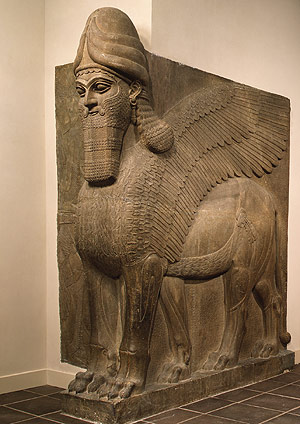Lamassu
 Neo-Assyrian period, 883-859 BCE. Palace of Assurnasirpal II, Mesopotamian, Assyria, Nimrud. Alabaster.
Neo-Assyrian period, 883-859 BCE. Palace of Assurnasirpal II, Mesopotamian, Assyria, Nimrud. Alabaster.This statue was one of two sculptures placed on both sides of the gates of the Palace of Assurnasirpal II, during the Neo-Assyrian period. Its size - a little over ten feet tall, was characteristic of lamassus, placed at the gates as a symbol of the power, strength, and divinity of the civilization. This mythological creature features the body of a lion, standing for power or strength, the wings of an eagle, symbollic for great speed, and the head of a human with great intelligence.At the same time, we know this creature to be a deity by its horned headdress, and its protective powers were believed to ward off evil or destructive forces from the palace. It has five legs, and as a result, it appears to be standing firm from the front, but from the side appears to be moving forward, perhaps symbollic of the civilization's increasing power.
Image:
"Lamassu". Metropolitan Museum of Art, New York. Available online atwww.metmuseum.org.
Sources:
"Lamassu". Ancient Near East, Inc. Available online at www.ancientneareast.com. Accessed 17 July 2006.
Stokstad, Marilyn. "Art of the Ancient Near East". Art History. Revised Second Edition, Vol. 1 p. 27.
"Lamassu". Metropolitan Museum of Art, New York. Available online at
Sources:
Stokstad, Marilyn. "Art of the Ancient Near East". Art History. Revised Second Edition, Vol. 1 p. 27.

0 Comments:
Post a Comment
<< Home